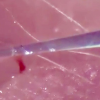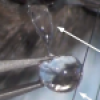The mouse eye is an important genetic model for the translational study of human ophthalmic disease. Blinding diseases in humans, such as macular degeneration, photoreceptor degeneration, cataract, glaucoma, retinoblastoma, and diabetic retinopathy can be recapitulated in transgenic mice. Our team has extensive microsurgical experience with eyes, and we develop and share surgical methods for preclinical research that tests therapies we hope will eventually be used for humans. All studies are conducted in accordance with the ARVO Statement for Use of Animals in Ophthalmic and Vision Research.
Mouse Microsurgery
Projects
This surgical technique illustrates evisceration of the vitreous, retina, and lens from the mouse eye, separation by centrifugation, and characterization with protein assays

This surgical technique illustrates the injection of gene therapy vectors and stem cells into the subretinal space of the mouse eye.
This surgical technique illustrates removal of the mouse eye for high-thoughput phenotyping.
News

Apr 3 2011 | Posted In: 20/20 Blog
Highthroughput screening discovers new models for human blindness. Learn how to collaborate.
- ‹ previous
- 3 of 3



